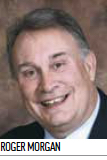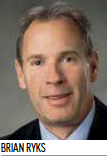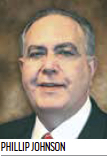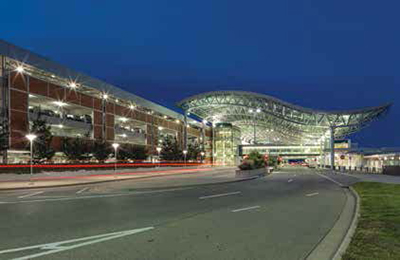Gerald Ford Int'l Changes From County Governance to Airport Authority Control

The new governing authority at Gerald R. Ford International (GRR) is confident that the airport is now better poised for increased growth and a stronger regional presence. On July 1, 2016, the Grand Rapids, MI, airport officially transitioned from county governance to control by the newly created Gerald R. Ford International Airport Authority. The transfer follows two years of discussions and three agreements between the authority and Kent County Board of Commissioners, as required by the FAA.
For the past 60 years, GRR had been owned and operated by Kent County through its Department of Aeronautics, with the county airport board deciding major policy matters. The transition to an airport authority, with members appointed by the Kent County Board of Commissioners, began in 2014 and required state legislative approval.
 FACTS&FIGURES FACTS&FIGURESProject: Change of Governance Location: Gerald R. Ford Int'l Airport (Grand Rapids, MI) Previous FAA Sponsor/Operator: Kent County Dept. of Aeronautics Current FAA Sponsor/Operator: Airport Authority, with members appointed by Kent County Board of Commissioners Project Consultant: Steven Baldwin Associates Transition: 2014 - July 2016 Key Dates: Governor signed required legislation on June 30, 2015; county board formed the regional authority & adopted articles of incorporation on Aug. 27, 2015; county & authority signed final operating & lease agreements on Dec. 17, 2015; FAA granted final approval on July 1, 2016 |
Governor Rick Snyder signed the necessary legislation on June 30, 2015, and the Kent County Board of Commissioners formed the regional authority and adopted articles of incorporation on Aug. 27, 2015. Kent County and the authority subsequently signed final operating and lease agreements on Dec. 17, 2015. Final approval for the authority came from the FAA, which granted and signed the authority's operating certificate on July 1st of this year. GRR marked the official transfer of its governance to the regional airport authority board during a ceremony attended by FAA officials, Kent County commissioners, airport board members and state legislators including Senators Peter MacGregor and Tonya Schuimaker, and Representative Rob Verhuelen, among others.
"This is a historic day for our region, our county and our airport," said Roger Morgan, Kent County commissioner and chairman of the newly created Gerald Ford International Airport Authority, at the July ceremony. "The transfer to an authority has been a goal of our board's for several years, and to see the teamwork, the collaboration of organizations and the FAA's support has been truly remarkable."
Morgan characterized the process as smooth and thanked key players and airport employees for their support during the transition.
Kent County continues to own the airport land, but the authority now handles day-to-day operations through a lease agreement with the county. Airport officials explain that the new structure creates an independent governing enterprise that is solely focused on developing the airport. Key elements of the new authority's mission include increasing economic development and proactive commercial revenue development, creating a stronger regional focus to respond to air service needs and developing a more entrepreneurial, business and hospitality management focus-all driven by customer service.
The agreement is being implemented at a time when the airport is investing tens of millions of dollars in capital improvement projects, including a storm water runoff system, a consolidated security checkpoint area and additional parking.
It's also a time of record-setting traffic for GRR. By May, the airport had already served more than 1 million passengers for the year-the earliest that that milestone has been reached in the airport's history. In 2015, GRR set a new all-time passenger record with more than 2.5 million passengers, an increase of 9.2% from the previous year. With nonstop flights to 23 U.S. cities, GRR is the second-largest airport in Michigan, behind Detroit Metropolitan.
GRR recently received two major accolades from Airports Council International-North America (ACI-NA): Top North American airport (2 to 5 million passenger category) in its Service Quality Award program and a 2016 Environmental Achievement Award.
 While the transfer of governance to an authority with an autonomous board could take up to a year to fully implement, it should further strengthen the airport's position as a regional hub that serves all of western Michigan and connects to important international hubs, says Brian Ryks, the airport's former executive director, now chief executive officer and executive director at Minneapolis-St. Paul International Airport.
While the transfer of governance to an authority with an autonomous board could take up to a year to fully implement, it should further strengthen the airport's position as a regional hub that serves all of western Michigan and connects to important international hubs, says Brian Ryks, the airport's former executive director, now chief executive officer and executive director at Minneapolis-St. Paul International Airport.
Making the Transition
Documents required for the FAA application included a Lease and Asset Transfer Agreement, which moves the airport's assets, buildings, fixtures, equipment, personal property, employees and financial obligations from the county to the authority.
Under a reorganization associated with the governance transfer, the airport is managed and operated by a president/chief executive officer, senior vice president/chief operating officer, vice president/chief financial officer, and a management team of directors. Together, they lead a 100-person staff and head the airport's primary functional areas: engineering and facilities, public safety and operations, marketing and communications, and human resources. On July 1, staff members were officially transitioned from Kent County employees to authority employees.

As consultant for the transition, Steven Baldwin Associates managed multiple details of the governance transfer application and approval. Individual elements included:
• completing Assignment and Assumption Agreements, which transferred the rights, titles and interests under all Passenger Facility Charge Records of Decision and all outstanding grant agreements between the FAA and county;
• drafting and lobbying for state legislation to enable establishment of the authority-a measure that passed unanimously;
• assembling and organizing thousands of pages of records and agreements needed for the FAA application;
• transferring county-run functions at the airport such as human resources and information technology;
• and various other administrative and regulatory details.

One of the key administrative details was providing staff extension services, which allowed GRR to install its own personnel manager onsite prior to the official transfer. "Part of our role was to keep the transition smooth by making sure airport employees stayed informed as to the transfer process and how it would affect them," explains Steve Baldwin, the consulting firm's president and chief executive. Employees did not lose any benefits and even made some minor gains, he notes. Except for a few early retirements, all airport staff became authority employees.
Regarding service development, the consulting firm researched demographics at similar county-owned airports and found that GRR had been lagging in some respects. "It was felt by many involved that the move away from county control would lead to higher autonomy and greater ability to move more swiftly, especially when courting airlines," notes Baldwin. "Today's airports can no longer simply wait for the offers to come in."
 Initial efforts to create an autonomous airport authority board at GRR date back to 2008, with regional alliances and economic development groups advocating for capital improvements and development to support the expansion of a modern and convenient airport that could connect to major hubs. Building on initial input from the business development groups, GRR's board researched structures and options for the most effective airport governance. After all parties involved agreed that an authority would be in their best interests, the board hired Steven Baldwin Associates to oversee the process, due to the firm's national reputation for successful governance transfer approvals and strong working relationship with the FAA.
Initial efforts to create an autonomous airport authority board at GRR date back to 2008, with regional alliances and economic development groups advocating for capital improvements and development to support the expansion of a modern and convenient airport that could connect to major hubs. Building on initial input from the business development groups, GRR's board researched structures and options for the most effective airport governance. After all parties involved agreed that an authority would be in their best interests, the board hired Steven Baldwin Associates to oversee the process, due to the firm's national reputation for successful governance transfer approvals and strong working relationship with the FAA.
Pros & Cons
Early in the process, some Kent County leaders expressed hesitation about plans to replace GRR's existing governing structure with an airport authority. Several commissioners questioned whether a change requiring new state legislation would be worth the trouble. Proponents of creating an authority pointed to the success that the Regional Air Alliance of West Michigan had in bringing several low-cost airlines to Kent County as an example of what an authority could accomplish for the flying public. A group of private business leaders formed the alliance in 2010 because GRR was considered to have high fares, explain airport officials.

Proponents also noted that the recent trend among top-100 U.S. airports has been toward reorganizing with airport authorities for governance. Supporters reasoned that an authority structure would be more autonomous and free from county wage restrictions, thus allowing GRR to attract and keep talented employees. Those in favor also argued that the move would help make the airport more competitive in attracting new airlines and responding to the flying public's needs.
Commissioner Roger Morgan, chair of the new authority board, feels the airline industry has changed and that profit-oriented airlines no longer pursue airports to provide service. "When the airport operated as a public utility model, it served us pretty well because the airlines were coming to us," Morgan remarks. "But, given a changing industry, we needed to become nimble in the marketplace and be more competitive."
Morgan credits the previous airport board for having the foresight and wisdom to prioritize efforts to change governance. "Over the years, Kent County provided a sound framework for the development of a first-class, small-hub airport," he comments. "Transitioning from this model to an airport authority, however, is allowing the airport to truly take off-operating less like a utility and more like a commercial enterprise."
Phillip Johnson, GRR's acting president and chief executive, agrees that moving to an airport authority governance model gives the airport greater flexibility to develop policies and procedures and provides greater opportunities for collaboration. "We are fortunate to have regional leaders who understand the challenges of this industry and are willing to work with us, knowing that in the end, what benefits the airport will benefit our entire region," Johnson says.
GRR officials note that the new regional authority reflects the full service area of the airport in ways a city or county body could not. They reason that an authority is a stronger operating model, because a regional perspective creates a stronger platform for economic development.
"For all involved, the transition should be a huge success," Johnson summarizes. "The airport will become more business-centric and commercially focused, and our local and regional communities will have an airport that truly reflects the entrepreneurial spirit that epitomizes Western Michigan."
2022 Charlotte Douglas International Airport Report of Achievement
 Giving back to the community is central to what Charlotte Douglas International Airport and its operator, the City of Charlotte Aviation Department, is about, and last year was no different.
Giving back to the community is central to what Charlotte Douglas International Airport and its operator, the City of Charlotte Aviation Department, is about, and last year was no different.
Throughout 2022, while recovering from the COVID-19 pandemic, we continued our efforts to have a positive impact on the Charlotte community. Of particular note, we spent the year sharing stories of how Connections Don't Just Happen at the Terminal - from creating homeownership and employment opportunities to supporting economic growth through small-business development and offering outreach programs to help residents understand the Airport better.
This whitepaper highlights the construction projects, initiatives, programs and events that validate Charlotte Douglas as a premier airport.
Download the whitepaper: 2022 Charlotte Douglas International Airport Report of Achievement.








